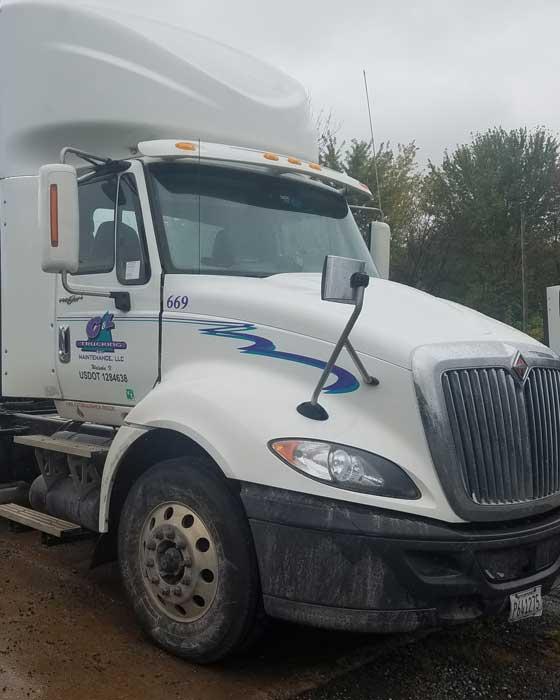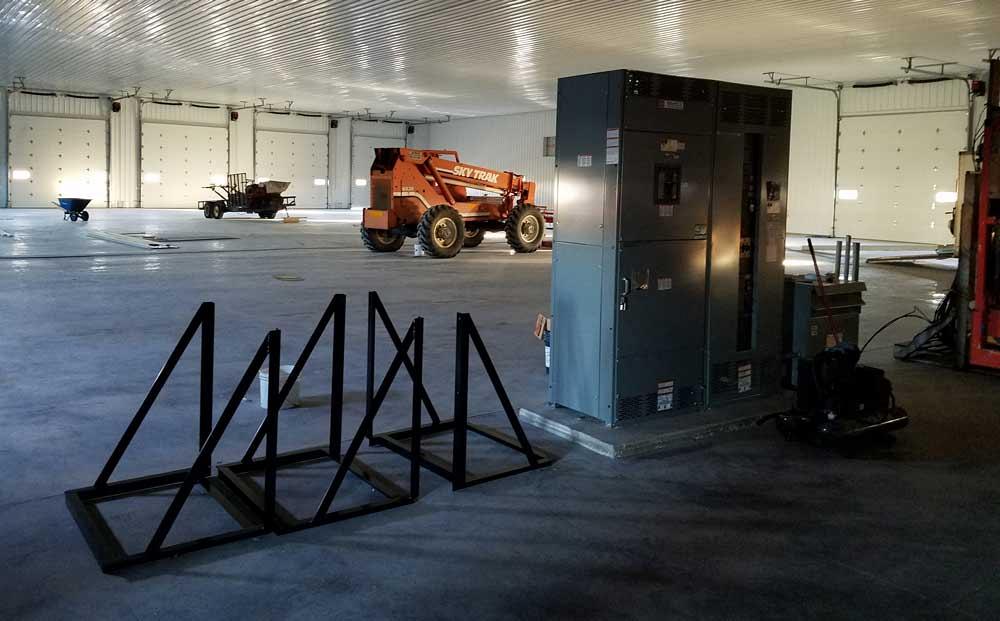Contributing editor
- FMA
- The Fabricator
- FABTECH
- Canadian Metalworking
Categories
- Additive Manufacturing
- Aluminum Welding
- Arc Welding
- Assembly and Joining
- Automation and Robotics
- Bending and Forming
- Consumables
- Cutting and Weld Prep
- Electric Vehicles
- En Español
- Finishing
- Hydroforming
- Laser Cutting
- Laser Welding
- Machining
- Manufacturing Software
- Materials Handling
- Metals/Materials
- Oxyfuel Cutting
- Plasma Cutting
- Power Tools
- Punching and Other Holemaking
- Roll Forming
- Safety
- Sawing
- Shearing
- Shop Management
- Testing and Measuring
- Tube and Pipe Fabrication
- Tube and Pipe Production
- Waterjet Cutting
Industry Directory
Webcasts
Podcasts
FAB 40
Advertise
Subscribe
Account Login
Search
Trucking in metal fabrication: Delivering on promises
Should a fabricator buy its own trucks? In truth, it depends
- By Kate Bachman and Tim Heston
- December 4, 2017
- Article
- Shop Management
Shop operations may be stellar, procedures documented, everyone trained and engaged, the operation a well-oiled machine. Quality parts flow through laser cutting, bending, welding, and finishing quickly. They get to packaging, are loaded on the truck … then arrive at the customer’s facility late or damaged. Or perhaps the driver was rude or otherwise unprofessional.
A fabricated part that’s damaged or delayed, or both, during shipping basically destroys all the value that went into making it—the painting, polishing, grinding, welding, bending, cutting, engineering, and order planning. It’s a reason that many custom fab shops decide to deliver at least some products with their own trucks. It gives them more control and direct customer contact. Drivers chat with people at customers’ loading docks, ask questions, receive feedback, find out what the customer likes and dislikes, and returns to the fabricator with valuable information.
Considering this, when should a custom fabricator make the leap, buy its own trucks, and hire its own drivers?
A Fabricator and a Trucking Company
For a unique perspective, The FABRICATOR spoke with Shane Dittrich, president and CEO of Watseka, Ill.-based T&D Metal Products and its sister company C&L Trucking and Maintenance. Dittrich and Managing Partner Jay Morris operate a network of firms that together form a unique business model.
Named for Dittrich’s sons, Cole and Lance, C&L has grown tremendously since it launched in 2004. “We’ve got 23 trucks on the road every day, servicing ourselves and other customers,” Dittrich said, adding that three are box trucks while the remaining are full-size tractor-trailers.
Dittrich and Morris got into the delivery business in an unconventional way. Typically, a fabricator decides to bring delivery in-house to gain control over the process. T&D’s delivery didn’t start in fabrication at all but instead with another sister company, this one in the landscaping business. That business required trucks to deliver plants and supplies to job sites. That landscape business no longer exists, but the trucking company it helped create is thriving.
“We bought our first truck to service that landscaping business,” Dittrich said. As the landscape business’s trucking capability expanded, managers realized they could start servicing T&D and, eventually, other businesses.
Today C&L delivers the raw material and products to and from not only T&D but also other area companies. C&L also expanded its truck maintenance operation, recently moving from a 14,000-square-foot facility into a 34,000-sq.-ft. building that can hold about 44 trucks, double the current fleet. The facility services C&L trucks as well as trucks for other operators—another revenue stream.
Building more revenue streams is the whole idea behind Dittrich and Morris’ network of sister companies. This network also includes 22 NAPA stores, which rely on C&L’s delivery capability, primarily its three box trucks. All these companies were launched to build a business model of diversification, and their revenue lines are complementary. More work for T&D and the network of NAPA stores means more work for C&L Trucking and Maintenance.
All in all, about 30 percent of C&L’s revenue comes from work within the T&D family of businesses, while 70 percent comes from outside customers.
People, Training, and Regulations
T&D doesn’t always use its own trucks. For certain jobs, less than load (LTL) carriers offer better service and pricing, especially for nonlocal shipments and jobs delivered on shipping lanes where another carrier might be more competitive. Deciding whether to bring trucking in-house is really like anything else in business. It has risks and rewards that shop managers should consider before making the leap.

C&L Trucking and Maintenance, a sister company of T&D Metal Products, has 23 trucks, three of them box trucks and 20 of them big rigs.
Consider the challenge of finding and hiring qualified truck drivers. Metal fabricators are no stranger to the skilled labor crisis, and neither are trucking companies. As Dittrich described, good delivery drivers can be an extraordinarily valuable employee for a fabricator. The best drivers even help grow a company’s business by asking questions and uncovering current and future needs at the customer’s plant.
But a fabricator’s truck drivers must also be good ambassadors. And if the job leaves a fabricator facility on time, the drivers need to deliver on time to the customer.
Also, people can’t learn to drive a big rig overnight. Insurance companies require people with commercial driver’s licenses (CDLs) to have experience before they can drive alone. And if a driver has had multiple infractions, like two speeding tickets and a wreck, he could be uninsurable. This is where gross vehicle weight (GVW) can make a big difference. It’s easier to find people to drive smaller trucks with GVWs of 26,000 pounds and less, and with air brakes. When a company operates big rigs—vehicles with GVWs of 80,000 lbs., with hydraulic brakes—the driver skill requirements are much more stringent.
“Finding good, safe drivers is the No. 1 challenge we have,” Dittrich said, adding that safety is one reason that C&L maintains its own trucks. “We service our own trucks, and we have a full-time mechanic who maintains the fleet to meet all the CSA 2010 regulations.”
CSA stands for compliance, safety, and accountability, and the rules come from the Federal Motor Carrier Safety Administration, part of the Department of Transportation. Further regulations come from EPA and OSHA.
“Trucking regulations have strict guidelines associated with your preventive maintenance program for your vehicles,” Dittrich said. “Vehicles are tested. There are just a lot of rules and regulations, and if you’re not up on them, it’s very difficult to manage a trucking business.”
Flexibility and Choice
It’s analogous to a fab shop owner staying away from powder coating. Why not partner with a local custom coater and not have to worry about all the EPA rules? On the other hand, bringing powder coating in-house does give a fabricator tremendous flexibility, the ability to offer more services, and have broader reach in the market. And if the area is simply underserved by high-quality, flexible custom coaters, bringing in powder coating may be a necessity. The same thinking goes for a fabricator that owns trucks.
But as Dittrich explained, even when a shop owns its delivery trucks, it probably won’t use them to deliver every job. Customers may determine the shipping method, of course. But even if a fabricator can choose the delivery method, using its own trucks isn’t always the best choice.
Sometimes this is obvious, particularly if a customer is outside the fabricator’s usual delivery area. A fabricator in Ohio probably won’t send a box truck all the way to California. Even for fabricators like T&D, which has extensive shipping capabilities, outside carriers still may have more capacity and, hence, better pricing on certain shipping lanes.
But sometimes even T&D chooses to contract not with C&L but with an outside carrier for local deliveries, especially with LTL carriers. It has to do with minimizing air (open, unpacked space) in the truck. The decision-making comes when customers demand smaller, more frequent shipments, which is not unusual at all these days. In many cases, C&L groups small jobs together on a truck and delivers to multiple T&D customers within a certain area.

C&L Trucking and Maintenance, a sister company of T&D Metal Products, is opening a new, 34,000-sq.-ft. maintenance facility this year.
Sometimes, though, an LTL carrier might offer better pricing, especially if a customer wants a very small order delivered regularly. “If they want, say, just one pallet delivered on a regular basis, we would probably ship it with an outside LTL carrier,” Dittrich said, “even if the destination is just 50 miles away.”
He emphasized that it all depends on the nature of the order, the space it takes up on the truck, delivery requirements, and, especially, the flexibility needed. This includes delivery times during the day. An outside carrier may offer good prices, but a truck may be able to show up only at certain times.
“An outside carrier’s truck may get here between 3:30 and 4 p.m.,” Dittrich said, “but we may need that truck here at 8 a.m. [Delivering with our own trucks], we can roll any time we want. It doesn’t have to be by someone else’s set schedule.” This gives the entire production schedule more flexibility, and it minimizes the time pallets of finished goods wait in the shipping department for the truck to arrive.
About Control
Here’s another big reason fabricators own their own trucks: They have control over the process. Such control includes incorporating shipping considerations into design-for-manufacturability work with the customer. Can the item be stacked? If not, is there a way it could be? Or is there a way the piece could be boxed or otherwise placed on a truck to minimize air?
Many fabricators choose to buy delivery trucks to minimize the chance of damage. Still, as Dittrich explained, the mere act of owning and operating trucks doesn’t by itself change the risk of damage or late deliveries. Poorly trained in-house drivers are more likely to damage parts and deliver late than experienced drivers employed by reputable carriers.
And the world has plenty of reputable carriers. Fabricators can contract with carriers that own the trucks or choose to work with shipping brokers, who match available shipments with trucks (e.g., independent drivers) in the area. Whatever the arrangement, fabricators need to make sure that drivers are professional, will show up on time and deliver on schedule—and that, of course, is never a guarantee.
Again, this isn’t a guarantee even if a fabricator were to choose to bring shipping in-house. In fact, if a fabricator were to bring shipping in-house, yet hire the wrong people or institute incomplete or incorrect training and maintenance processes, the fabricator would be in worse shape than it was before. A shipment that arrives damaged or late at a customer facility is never a good thing, and neither is a rude or inconsiderate driver. But if that driver and truck bear the fabricator’s name and logo, the situation becomes even worse.
Risk and Reward
Like any other decision a shop owner or manager makes, deciding to invest in trucks and drivers has its risks and rewards. Dittrich said that by far the greatest reward has been shipping flexibility, the ability to ship products at a time most convenient for the fabricator and the customer.
But is this reward worth the associated risks of hiring and training drivers, managing a maintenance routine, and complying with all the rules and regulations? That depends on the options available and the variability of the fabricator’s product mix. This includes the consistency of demand; order quantities; and the shape, size, and other physical attributes of the products a fabricator needs to ship.
For T&D, the move has made sense, not only to better serve its customers, but also to diversify and grow its revenue streams. Overall, the family of companies has more than doubled revenue over the past five years. Building its unique business model—part manufacturer, part trucking company, part NAPA stores owner—is apparently paying off.
Images courtesy of C&L Trucking and T&D Metal Products, 815-432-4938, www.tdmetal.com.
About the Authors

Kate Bachman
815-381-1302
Kate Bachman is a contributing editor for The FABRICATOR editor. Bachman has more than 20 years of experience as a writer and editor in the manufacturing and other industries.

Tim Heston
Senior Editor
2135 Point Blvd
Elgin, IL 60123
815-381-1314
Tim Heston, The Fabricator's senior editor, has covered the metal fabrication industry since 1998, starting his career at the American Welding Society's Welding Journal. Since then he has covered the full range of metal fabrication processes, from stamping, bending, and cutting to grinding and polishing. He joined The Fabricator's staff in October 2007.
subscribe now

The Fabricator is North America's leading magazine for the metal forming and fabricating industry. The magazine delivers the news, technical articles, and case histories that enable fabricators to do their jobs more efficiently. The Fabricator has served the industry since 1970.
start your free subscription- Stay connected from anywhere

Easily access valuable industry resources now with full access to the digital edition of The Fabricator.

Easily access valuable industry resources now with full access to the digital edition of The Welder.

Easily access valuable industry resources now with full access to the digital edition of The Tube and Pipe Journal.
- Podcasting
- Podcast:
- The Fabricator Podcast
- Published:
- 04/16/2024
- Running Time:
- 63:29
In this episode of The Fabricator Podcast, Caleb Chamberlain, co-founder and CEO of OSH Cut, discusses his company’s...
- Trending Articles
Tips for creating sheet metal tubes with perforations

Supporting the metal fabricating industry through FMA

JM Steel triples capacity for solar energy projects at Pennsylvania facility

Fabricating favorite childhood memories

Omco Solar opens second Alabama manufacturing facility

- Industry Events
16th Annual Safety Conference
- April 30 - May 1, 2024
- Elgin,
Pipe and Tube Conference
- May 21 - 22, 2024
- Omaha, NE
World-Class Roll Forming Workshop
- June 5 - 6, 2024
- Louisville, KY
Advanced Laser Application Workshop
- June 25 - 27, 2024
- Novi, MI



























